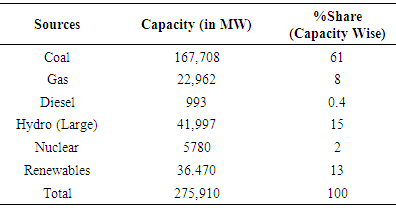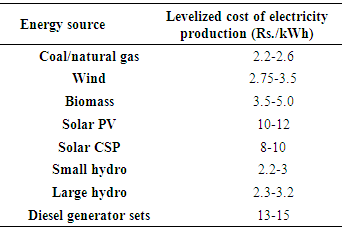-
Paper Information
- Paper Submission
-
Journal Information
- About This Journal
- Editorial Board
- Current Issue
- Archive
- Author Guidelines
- Contact Us
International Journal of Energy Engineering
p-ISSN: 2163-1891 e-ISSN: 2163-1905
2017; 7(1): 32-38
doi:10.5923/j.ijee.20170701.03

Impact of Renewable Energy Consumption on Economics in India
Farzaneh Haghighat Nia1, Hossein Niavand2
1Research Scholar, Department of Studies in Commerce, University of Mysore, Mysore, India
2Research Scholar, Department of Business Administration, University of Mysore, Mysore, India
Correspondence to: Hossein Niavand, Research Scholar, Department of Business Administration, University of Mysore, Mysore, India.
| Email: |  |
Copyright © 2017 Scientific & Academic Publishing. All Rights Reserved.
This work is licensed under the Creative Commons Attribution International License (CC BY).
http://creativecommons.org/licenses/by/4.0/

Energy is the major source for the economic development of any country. In recent years, India energy consumption has been increasing at a relatively fast rate due to population growth and economic development. Energy plays substantial role in economic, hence relationship between energy consumption and economic growth is an important issue for economists. Renewable Energy (RE) has been identified as a key tool to counter climate change and enhance energy security. In India growth of the economy places heavy demand of electric power, Presently Coal-based power generation is characterized by local and regional environmental degradation as well as greenhouse gas emissions, leading to climate change. Thus, there is need for enhance energy security along with reducing greenhouse gas emissions. Renewable energy is one of the environmentally friendly sources of energy and effectiveness of growth economic, in this article will be show that an effects of RE for economy in India.
Keywords: Renewable Energy, Economics, Energy Consumption, Development of economy
Cite this paper: Farzaneh Haghighat Nia, Hossein Niavand, Impact of Renewable Energy Consumption on Economics in India, International Journal of Energy Engineering, Vol. 7 No. 1, 2017, pp. 32-38. doi: 10.5923/j.ijee.20170701.03.
Article Outline
1. Introduction
- Today, energy production and benefit accounting for two third of the world's greenhouse-gas emissions GHG [5], there has been global works towards shifting the available fossil fuel based energy systems to low-carbon technologies, including renewable energy technologies (RET) like solar, wind, hydro and biomass. International Energy Agency (IEA) has measured that towards limiting the temperature rise to two degree centigrade (450 ppm, or, ppm scenario by 2050) [32], the total installed capacity of renewable energy sources for electricity production needs to be augmented 3770 GW by 2035. This shall require annual investments of over US $550 billion in climate change mitigation and adjustment technology [11].India is the fourth largest energy consumer in the world after the United States, China and Russia [18]. As of March 2013, the per capita total electricity waster in India was 917.2 kWh [10]. Electricity waster in India is expected to rise to around 2280 Bkwh by 2021–22 and around 4500BkWh by 2031–32 [9]. India's energy waster has been increasing comparatively fast rate due to increase in population and living standard as well. Current centralized energy planning of India is mainly dependent on thermal power plant for energy need and its percentage share is near about 70% of total installed capacity of power plant [17]. The reasons for according renewable energy may vary in case of developed and developing economies. Developed nations are promoting clean energy technologies due to their heightened sensitivity towards the environment and being mandated under the various international climate conventions like the United Nations Framework on Climate Change, or, UNFCCC [16]. On the other hand, the reasons for developing economies to advocate renew able energy technologies include enhancement of their energy security (reduction in energy imports), besides bridging the energy deficit and enabling energy access to the masses through decentralized systems in form of lifeline energy services like cleaner forms of basic lighting devices (solar lanterns) and cooking systems (biogas plants).India has its own sets of reasons for pursuing a low-carbon growth direction. This includes largeshare of fossils in its energy supply chain (over 80% share of coal based power in the grid) [8], leading to high levels of greenhouse gas (GHG) emissions, making it the fourth largest emitter globally [22]. It is also promoting renewable energy in decentralized formats to enable energy access to the un-electrified/ under-electrified rural masses.It has envisioned 15% of electricity contribution from renewable energy sources by 2020 as against the present share of 6% [29], advocated under the National Acton Plan on Climate Change (NAPCC). The electricity requirement is projected to increase to 1900 Billion units (BU) by the year 2022 [30], from the present levels of about 1100 BU [27]. Hence, over 300 BU of green power would be required as against the present levels of 60 BU [19], (fivefold increase). This shall necessitate significant scaling up of RE capacity in similar terms.Renewable Energy projects are associated with high opposite (capital) cost and lower levels of energy generation (due to limited availability of natural resources like solar radiation and wind velocity), leading to higher cost of energy generation. Besides, they lack the ability to reach economies of scale (due to limited availability of contiguous land area in resource rich regions); most wind and solar projects are limited to not more than few hundred megawatts of capacity.The developing economies, there are constraints in terms of availability of monetary resources at competitive terms due to competing demands from other sectors like education, healthcare, agriculture and infrastructure. As such, it is of paramount importance that utilization of scare resources is done in the most prudential manner.
|
2. Energy Scenario of India
- India became the world’s third largest producer of electricity in the year 2013 with 4.8% global share in electricity generation surpassing Japan and Russia but is still a power deficit country [12]. Despite tremendous grow thin electricity generation, country continues to face both energy and peak deficit. During the year 2014–15, there would been energy shortage of 5.1% and peak shortage of 2.0% [1]. As the economy grows in coming years the electricity demand will further rise as there is strong correlation between rise in energy consumption and economic growth. India has been putting steady efforts at increasing its energy generation capacity. However, the demand for energy has been continuously out stripping supply. The table given below indicates the region wise installation capacity of different sources of electricity. State- owned and privately owned companies are significant players in India’s electricity sector, with the private sector growing at a faster rate. India’s central government and state governments jointly regulate electricity sector in India. Source of Energy:The Indian power sector is one of the most diversified in the world. The sector has been continuously progressing in generation capacity addition through conventional like Coal, lignite, gas, hydro and nuclear power as well as non-conventional sources like Wind, solar, small hydro and biomass. Total installed capacity of power plant in the country stands at 253.39 GW in which, Thermal power accounts for 69.5%, Renewable energy accounts for 12.5%, Nuclear 2% [13] and Hydro holds a 16% share.
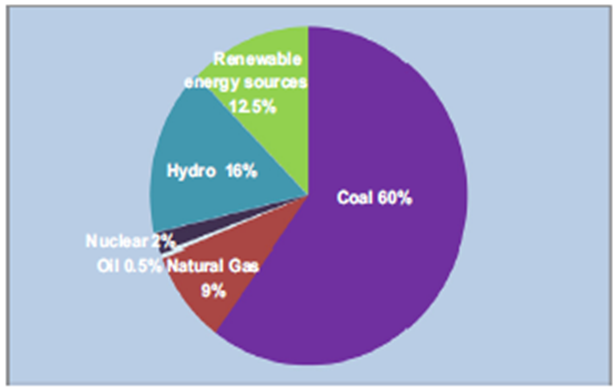 | Figure 1. Sources of electricity of India |
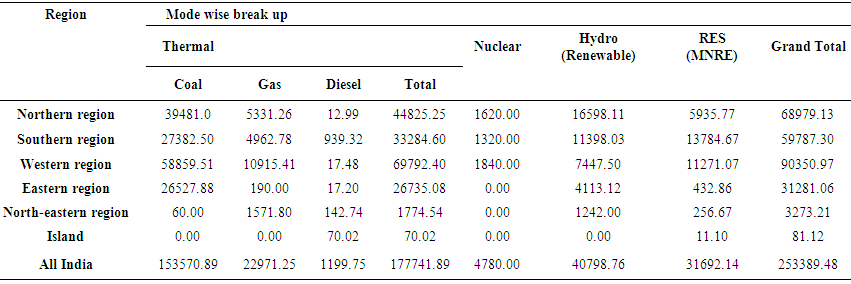 | Table 2. All India Installed Capacity in (MW) of Power |
3. Renewable Energy
- Renewable energy is derived from natural processes that are replenished constantly. India is blessed with a variety of renewable energy sources, the main ones being biomass, biogas, sun, wind, geothermal, tidal and small hydro power. (Large hydro power is also renewable energy in nature, but has been utilized all over the world for many decades, and is generally not included in term new and renewable source of energy). India's electricity sector is amongst the world's most active players in renewable energy utilization, especially wind energy [25]. As of 31 March 2014, India had an installed capacity of about 31.69 GW of non-conventional renewable technologies-based electricity [17].
|
 | Scheme 1. Wind Energy in India |
 | Scheme 2. Solar Energy in India |
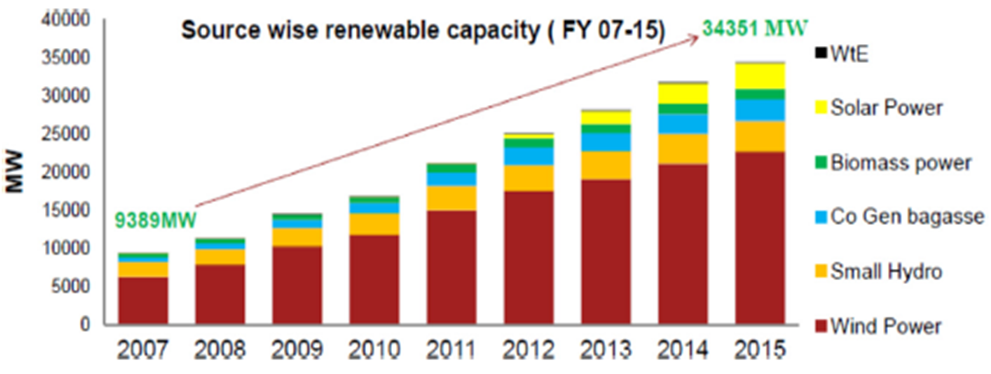 | Figure 2. Renewable Energy in India |
 | Figure 3. Renewable Energy future in India |
4. Renewable Energy Policy
- International Renewable Energy Agency (IRENA) has defined the following mechanisms as key policy instruments which have been adopted across the globe in varying formats [7]. Each of them has been tagged with the applicable policy/regulation as valid in the case of India [14].A) Grant/subsidyIt is the monetary assistance that helps in reducing the initial investment in a project to enhance its viability and the same is not required to be paid back. The Government of India provides subsidy under various schemes to promote the use of renewable technologies till they attain commercial status.B) Accelerated depreciationAllows investments in renewable projects to be fully or partially deducted from tax obligations or income; it is a kind of production tax credit. Depreciation up to 80% can be claimed in lieu of investments made in solar and wind energy projects in India [21].C) Tax concessions/exemptionsEnables reduction in tax outgo on profits earned from renewable projects. Infrastructure projects (including conventional power and renewable power sectors) are exempted from payment of Income tax for 10 consecutive years within the first 15 years of their commissioning. However, they are required to pay Minimum Alternate Tax MAT (present rate of MAT is 20.81%). For remaining years, the company has to pay corporate tax (present rate is 33.99%) [15].D) Preferential tariffUtilities are bound to purchase power generated from RE projects at a fixed price for a specified number of years. In case of India, the price is determined by the respective state electricity regulatory commission (SERC), or central electricity regulatory commission (CERC) as the case may be [35].E) Renewable purchase obligationsDesignated consumers (distribution utilities and large power consumers) are required to procure a certain percentage of their total power consumption from RE sources. This can be in terms of actual purchase of RE power, or by way of tradable green certificates.In India, the renewable energy certificates (REC) can be sold and purchased through the energy exchanges [34, 33].
5. Economic Viability of Renewable Energy
|
6. Conclusions
- Developing economies have set ambitious Renewable Energy capacity addition targets to reduce energy exportation on estimate of their growing and developing economy.It was estimated that the emissions of greenhouse gas can be reduced from 4% to 45% in the upcoming years of 2020. These include up to 14% by replacing coal with renewable energy.India has sufficient potential of renewable energy but combination of the right technology and correct human behaviour is needed because every technology have their own limitation, then having peoples readiness to accept of Renewable Energy.India will can be use many of these tools innovatively to achieve an impressive growth in its Renewable Energy sector with a high impact on the ground (green power generation) and a low dependency upon financial support.
 Abstract
Abstract Reference
Reference Full-Text PDF
Full-Text PDF Full-text HTML
Full-text HTML